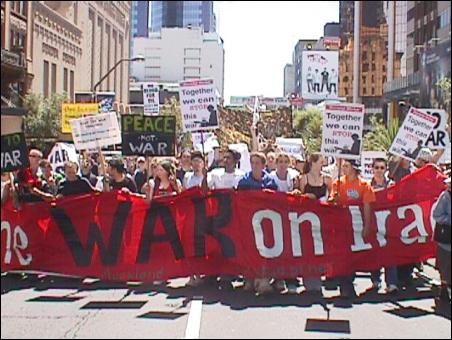 Auckland's last really big political demonstration, the 2003 protest against the Iraq War. The march stretched the full length of lower Queen Street, and was estimated at 20-25,000 strong. Today's hikoi (no pics available as yet) was the same size - but the mainstream news media put its strength at between 2,000 and 7,000. Why?
Auckland's last really big political demonstration, the 2003 protest against the Iraq War. The march stretched the full length of lower Queen Street, and was estimated at 20-25,000 strong. Today's hikoi (no pics available as yet) was the same size - but the mainstream news media put its strength at between 2,000 and 7,000. Why?I’VE JUST RETURNED from the Auckland hikoi to discover that the mainstream news media are downplaying the significance of the demonstration by citing absurdly low estimates of the turnout.
Radio New Zealand is the worst offender, running for the past two hours with a figure of 2,000 (barely enough people to fill a city block).
The NZ Herald at least quotes a police officer, whose (wildly inaccurate) estimate was 5,000-7,000 marchers.
Now, let’s get real.
The march extended the full length of lower Queen Street – i.e. from the assembly-point in QEII Square to the Town Hall.
Just so we’re clear: that means that as the front ranks were arriving at the Town Hall, the last ranks were leaving the Square.
What’s more, the marchers occupied the full width of the carriageway – i.e. they stretched right across the road, from pavement to pavement.
This makes the calculation of the demonstration’s size very simple – if you know your history.
Since the late-1960s there have been several demonstrations that occupied the whole of lower Queen Street. There was the 1971 "Mobe" (mobilisation) against the Vietnam War. Ten years later there was the May 1st "Mobilsation Against the Tour" march up Queen Street. In 1983 there was a big union protest against Muldoon’s Wage-Price Freeze. In 1991 there was an even bigger union protest against the Employment Contracts Bill. In 2002 there was the Anti-GE March, and in 2003, Auckland’s last really big demonstration – until today – against the Iraq War.
Contemporary media cited those protests at between 20,000 and 30,000 strong.
Have human-beings doubled or tripled in size since 2003? Of course not! So where do these absurd figures of 2,000, 5,000 and 7,000 come from?
Is it because the reporters on the spot (and the policemen) have so little experience of large political demonstrations that they simply have no idea how to estimate their true size? I hope so, because the alternative – that reporters and the Police are deliberately underestimating the size of the protest for political/ideological reasons – is just too upsetting to contemplate.
Something historic happened on the streets of Auckland today. It would be nice if the news media could report it accurately.
FOOTNOTE: If we assume lower Queen Street to be roughly a kilometre in length and about 30 metres wide we get an area of 30,000 square metres. Now, if every protester is assumed to occupy just one square metre of space as he or she moves up Queen Street – that’s a maximum of 30,000 protesters, or, allowing for the odd gap, a minimum of 20,000. Basic arithmetic, really. What’s the matter with all our journalists!

6 comments:
There's a good photo of the crowd among the Herald's lot available here: http://www.nzherald.co.nz/nz/news/image.cfm?c_id=1&gal_cid=1502728&gallery_id=105784.
The march look about 25 wide - so four rows of people gets you 100 people. I guess the question you need to answer is do you think there were 1000 full rows of marchers. Did the march go right to the bottom of Queen Street, then your answer answer could well be yes.
There is perhaps a comparison to be made with the photograph in your "Dangerous Winners" post below. Are they comparable groups?
More pics here- it was huge.
http://socialistaotearoa.blogspot.com/2009/05/massive-turnout-for-hikoi.html
The rule of thumb is to double the NZ Herald figures to get a count approaching an accurate one. Full width of Queen St is important as is the tail still marching when the bulk are in Aotea Square. I was on all the events Chris mentions save the ’71. Ocasionally you will get an honest police commander, but not this time. The numbers are important for obvious reasons.
Going from the photos of the width of the protest, and claims of it's length, Trotter's estimation may be conservative.
Trotter's conjecture of possible political bias by the police and the media need to be answered by these organisations.
Their credibility is at stake if they cannot explain how they arrived at their figures.
this is worth having a look at
http://www.youtube.com/watch?v=Qb6SicIb_is
Fair call Chris.
Teaching junior journos to count crowds
is an important art.
RNZ News
Wgtn
Post a Comment